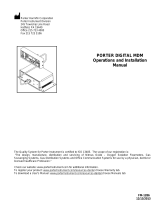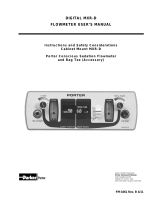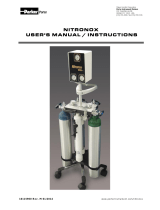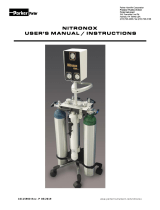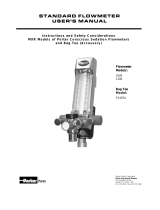Page is loading ...

1 10545100-Australia Rev. A 09/2020
Parker Hannifin Corporation
Precision Fluidics Division
Porter Instrument
245 Township Line Road
Hatfield, PA 19440
Office 215 723 4000
Fax 215 723 5106
Digital MDM® Mixer
Operations Manual
This product complies with the Medical Device Directive (93 / 42 / EEC).
A “Declaration of Conformity” in accordance with the directive has been made and is on file.
The Quality System for Porter Instrument is certified to ISO 13485. The scope of our registration is:
“The design, manufacture, distribution and servicing of fluidic components and integrated systems for use in the Medical
Equipment, Diagnostic, Biopharmaceutical, Agent Detection, Analytical Instrumentation and Industrial markets, Nitrous
Oxide – Oxygen Sedation Flowmeters, Gas Scavenging Systems and Gas Distribution products for use by a physician,
dentist or licensed healthcare professionals and the distribution of Steam Sterilizers.”
Check our website: www.porterinstrument.com for additional information.

2 10545100-Australia Rev. A 09/2020
IMPORTANT: READ MANUAL COMPLETELY Before Operating This Device
Basic delivery technique is described. Also, this manual contains instructions on periodically required checks to be
performed by the user. These checks are necessary to ensure the proper performance of this device and its safety
features. Retain this manual for future reference.
WARNINGS AND PRECAUTIONS
These warnings and precautions are to help you to
understand how to safely operate the Digital MDM Mixer.
A WARNING alerts you to a possible hazard to people. A
CAUTION alerts you to the possibility of equipment
damage.
WARNING: Do not use this device for the administration
of general anesthesia or as a part of, or in conjunction
with, a general anesthesia administration system.
WARNING: Use scavenging. Workers are exposed to
N2O during administration of N2O/O2 conscious sedation
analgesia. Exposure should be minimized. Time
Weighted Average (TWA) for Australia is 25ppm (parts
per million). Refer to SDS (Safety Data Sheet) for Medical
Nitrous Oxide.
WARNING: The Digital MDM Mixer utilizes the
cross+protection system. The flexible hose and
connectors that connect to the flowmeter are diameter
indexed; 3/8” O.D.for Nitrous Oxide and ½” for Oxygen.
The cross+protection system is designed to prevent
misconnection of Oxygen and Nitrous Oxide piping. DO
NOT ATTEMPT TO CHANGE THE DIAMETERS OR
CONNECTORS OF THE FLOWMETER! Tampering with
the cross+protection system constitutes acceptance of
liability by the installer. For your own protection, as well
as that of the Doctor and the patients, use 3/8” O.D. tubing
for all Nitrous Oxide lines and ½” O.D. tubing for all
Oxygen lines.
To ensure safe operation and conformation to local fire
codes, all Digital MDM Mixer systems are designed to be
used with sedation delivery systems mounted inside walls
and they meet or exceed the guidelines established by the
National Fire Protection Association for Nonflammable
Medical Gas Systems, NFPA 99.
WARNING: During any power outage, remember to turn
OFF the flowmeter and manually turn OFF the cylinder
valves. With centralized, electrically powered gas
systems, if gas was flowing when the power went out and
the flowmeter is left ON, gas will be flowing when the
power is restored.
CAUTION: This device is intended to be used by medical
personnel trained in its use and the use of nitrous oxide
and oxygen for medical applications.
CAUTION: Always use clean, dry medical grade gases.
Introduction of moisture or other contaminants into this
device may result in defective operation.
CAUTION: Do not attempt to repair, alter or calibrate this
device. Unauthorized repair, alteration or misuse of this
device is likely to adversely affect the performance and
will void the warranty.
CAUTION: Never oil or grease any part of this system
(minimize fire or explosion potential). Cylinder mount: Do
not clean check valve entrance or sealing washer (replace
as needed) with disinfectant.
CAUTION: The user is responsible to choose how to
provide a cylinder valve clear of dust or dirt (which may
be carried to regulator and cause damage or accident).
One technique is “crack” [secure] cylinder valve before
installing cylinder to E-Block. Open valve slightly and then
close. Do not discharge flow of gas at any person or
flammable material.
WARNING: New or modified installations - properly
connected gas pipelines are absolutely essential to
patient safety. The authorized distributor or contractor
should provide written documentation that all gas
pipelines are connected properly, and that the system has
been pressure tested prior to use. While this is a good
business practice, it is important that the user verify by
their own test, independent of the authorized distributor or
contractor, that all gas pipelines are connected correctly
prior to using the system. The ultimate responsibility of
assuring that lines are not crossed rests with the
user.

3 10545100-Australia Rev. A 09/2020
Symbol
Description
MEDICAL EQUIPMENT WITH RESPECT TO ELECTRIC SHOCK, FIRE AND MECHANICAL
HAZARDS IN ACCORDANCE WITH UL 2601-1, AND CAN/CSA C22.2 NO. 601.1
Alternating Current
Protective Earth (ground)
Attention, consult the accompanying documents
Manufactured By
ELECTRICAL CONNECTIONS & GROUNDING INSTRUCTIONS
The unit must be grounded. If it should malfunction or breakdown, grounding provides a path of
least resistance for electrical current to reduce the risk of electric shock.
A known Protective Earth (ground) connection must be made via one of the following methods:
1) The third wire on the power cord when plugged into an appropriate outlet that is properly
installed and grounded in accordance with all local codes or ordinances.
2) The external ground lug on the rear of the device.
A Protective Earth (ground) connection is a connection attached to the facility grounding point
outside the facility. A licensed electrical person should be consulted to confirm the Protective Earth
(ground) connection.
Do not use an electrical cord with nicks, cuts, or other damage. Do not use the unit with an
extension cord as it will be subject to electromagnetic interference (EMI).
There are no user-serviceable parts inside this unit. A shock hazard exists if power is not
disconnected prior to any internal servicing or maintenance. Always disconnect the power source
before inspection or repair.

4 10545100-Australia Rev. A 09/2020
REQUIREMENTS AND FEATURES
Bag Tee (Breathing Bag) Requirements
A bag tee (with attached breathing bag or capped breathing bag port) containing an air inlet valve is required for use with
this unit. The bag tee is factory mounted on the unit or provided separately for remote mounting. Matrx by Parker Scavenging
Nasal Masks (or other suitable breathing circuits – see Breathing Circuits page 5) provide the patient connection. An
Anaesthetic Breathing Circuit incorporating Scavenging with face mask/nasal hood may also provide the patient
connections. Refer to: Breathing Circuits on page 5.
Use of Scavenging
A patient breathing circuit that incorporates scavenging and a one-way exhalation valve must be used with this device. For
applications other than Dental use, a separate Scavenger Interface must be used with this system for connection between
patient breathing circuit and facility evacuation system. If used in a dental application, the scavenging tube of the patient
breathing circuit may connect directly to chair suction and a scavenging interface may not be required.
A Scavenger interface contains an internal pathway for gas passage permitting waste gas to follow a preferential path to
vacuum. Scavenger Interfaces must meet the following criteria:
Must be open to ambient air at either top or bottom of interface (via perforations)
Must contain a sintered filter for particulate capture
A barb tail connector for connection to wall evacuation system
A rigid conical 19mm connection for connection to the breathing circuit scavenging tube (refer AS/NZ 2496:
Breathing attachments for anaesthetic purpose for human use)
Note: Follow specific manufacturer Instructions for Use for individual Scavenger Interfaces
Monitor for N2O in the patient treatment area to ensure that controls are effective in achieving low PPM (parts per million)
exposure (TWA = 25ppm in Australia). Contact your dealer for details on monitors and testing.
Room Ventilation
Mechanical ventilation requirements shall conform to Australian Standard AS1668.2: The use of ventilation and air-
conditioning in buildings Part 2: Mechanical ventilation in buildings, Section 5: Enclosures used for particular healthcare
functions or those specified in The Australasian Healthcare Facility Guidelines and/or State and Territory Engineering
Services/Healthcare Infrastructure Guidelines and Specifications on air change requirements as applicable.
Facility Piping
The user MUST perform tests independent of the dealer or contractor to verify that all pipelines are connected correctly. If
you are unfamiliar with piping systems, refer to Australian Standard AS2896: 2011 Medical gas systems – Installation and
testing on non-flammable medical gas pipeline systems. The user has the ultimate responsibility for properly connected
pipelines essential to patient safety.
Sleeve Index System (SIS)
Gas connections in the DIGITAL MDM mixer are mechanically indexed using the Australian Sleeve Indexed System (SIS).
This feature helps to prevent the crossing of pipelines. Under no circumstances should these connections be altered.
Alarm Test
The user should test the alarm system for proper operation prior to each clinical use.
Machine Diagnostics
The Digital MDM Mixer performs self-checks at start up and during operation. If any errors are detected, the unit displays
EE on the % OXYGEN display and an error code on the LPM FLOW display. If an error code appears, remove the unit from
patient service and call Air Liquide Healthcare on 1300 36 02 02.
To aid in the diagnostics of the unit, make note of the final error code displayed on the unit.

5 10545100-Australia Rev. A 09/2020
INTENDED USE: FLOWMETER FOR ANALGESIA DELIVERY SYSTEM
The DIGITAL MDM mixer and accessories are analgesia gas mixing and delivery devices for use in medical procedures to
relieve pain and anxiety. The devices permit the trained operator to adjust the percent of oxygen through a range of 100%
to 30% (and thereby control the ratio of oxygen to nitrous oxide). The operator can also control the total volume of mixed
gas up to 9.9 liters per minute.
The Digital MDM Mixer may be used by a properly trained attending physician, dentist, or licensed professional provided
they monitor the patient and themselves for any evidence of contraindications as stated in section titled Side effects and
Contraindications on page 11.
Nitrous Oxide should not be used in the following circumstances, this includes but is not limited to:
Treatments that require a level of sedation greater than relative analgesia i.e. anaesthesia
Patients who have maxillofacial injuries
Patients who have a B12 deficiency
Patients who have intracranial or intraocular pressure
Treatments that require more than 24 hours of application.
Continuous Flow Systems
The Digital MDM Mixer continuous flow nitrous oxide and oxygen sedation system offers built in fail-safe mechanisms to
prevent the flow of nitrous oxide without oxygen. All flowmeters feature easy adjustment of both flow rates and percentage
N2O mixture (0-70%) allowing for predictable results across a wide variety of applications.
The Digital MDM Mixer delivers a continuous flow of gas and must be used with scavenging breathing circuits and/or
scavenging interface devices.
Note: When used in any application gas may disperse to room air creating a potential exposure risk to Nitrous Oxide. A
risk assessment should be conducted by facilities to assess exposure hazards and appropriate mitigation measures; eg:
Adequate ventilation and N2O monitoring. (See: Room Ventilation on page 4)
Breathing Circuits
Breathing circuits that can be used with any Porter and Matrx device include:
Porter “double mask” autoclavable nasal hood breathing circuit
Matrx by Parker Scavenging Nasal Mask breathing circuit with disposable or autoclavable nasal hoods
Porter Silhouette disposable nasal hood and breathing circuit
Porter Disposable medical breathing circuit with mask
Various breathing circuits that may be used with Porter and Matrx devices must meet several criteria:
22mm connection to the bag tee
One-way valve (either in the bag tee or breathing circuit) to prevent rebreathing of exhalations
Connection from the bag tee to a mask or nasal hood that the patient can comfortably wear or hold in place and
achieve a proper seal
Tubing or hose from the breathing circuit that can connect to a scavenging interface (19mm) and allow for adequate
vacuum flow to wall evacuation system
Gas Supply Connection
After installation of the flowmeter, connect the nitrous oxide and oxide supply lines to the Sleeve Indexed System (SIS)
fittings located on the back of the flowmeter unit. It is important that the regulators for both gases be set to give pressures
in the range of 365.4 kPa ± 13.7 kPa. Confirm the absence of leaks at pressure connections on the unit (hose ends). A leak
test using a soap/water solution can be used to determine if there is a leak. If there is a leak, soap bubbles will appear at
the leaking location. Refer to FM-916 Mobile “E” cylinder Stand Installation and Instructions for connecting gas supply to
the flow meter and cylinder installation to mobile stand.
User Responsibility
This product should not be repaired other than in accordance with written instructions provided by Matrx by Parker. The
user of this product shall have the sole responsibility for any malfunction which results from improper use, faulty
maintenance, improper repair, damage, or alteration by anyone other than a Matrx by Parker authorized repairer Air Liquide
Healthcare. It is the user’s responsibility to ensure that the correct gas, at the correct pressure, is supplied to the fittings at
the rear of the unit.

6 10545100-Australia Rev. A 09/2020
Description of Unit
The Digital MDM Mixer is shown in Figure 1. The device permits the operator to adjust the percent of oxygen through a
range of 100% to 30% (and thereby control the ratio of oxygen to nitrous oxide). The operator can also control the total
volume of mixed gas up to 9.9 liters per minute.
Mixture Control
The DIGITAL MDM mixer precisely mixes oxygen and nitrous oxide from local cylinders or pipeline gas systems, and
delivers the electronically controlled mixture to the bag tee outlet.
Built-In Safety
A series of alarms (see Safety Alarm System page 7) alert the user to any problem condition within the DIGITAL MDM mixer
unit or in the gas supply.
Displays and Indicators (Figure 1)
Flow Display: The LPM FLOW display (4) normally displays the total gas flow rate. It also displays the individual nitrous
oxide or oxygen flow rates when either the N2O or O2 flow display controls (6) are pressed. The gas flow being displayed is
indicated in the flow indicator (5) by O2, TOTAL or N2O.
% OXYGEN Display: The % OXYGEN display (3) indicates the oxygen concentration set point in the total flow.
Gas Flow Indicators: Gas flow is indicated by bar graph LEDs (1). A green bar graph represents O2 while blue represents
the N2O flow. The number of lit bars gives a graphical indication of the flow level of a particular gas.
Figure 1: Digital MDM Mixer Front Panel (figure shows all LEDs illuminated)

7 10545100-Australia Rev. A 09/2020
SAFETY ALARM SYSTEM
There are four alarm conditions on the Digital MDM Mixer.
They appear in the safety alarm display (see Figure 1, item
2) only when conditions warrant. Otherwise, they are not
visible. The alarm conditions are:
OXYGEN FAILURE: This alarm indicates that the set
oxygen (O2) flow cannot be delivered. Check the oxygen
supply. During an OXYGEN FAILURE alarm, the nitrous
oxide delivery is automatically shut off. The LPM FLOW and
% OXYGEN displays are off.
NITROUS FAILURE: This alarm indicates that the set
nitrous oxide (N2O) flow cannot be delivered. Check the
nitrous oxide supply. During a NITROUS FAILURE alarm,
the LPM FLOW display indicates oxygen flow and the %
OXYGEN display is off.
Both the OXYGEN FAILURE and NITROUS FAILURE are
self-canceling alarms. When the gas is restored, the unit
returns to the flow rate and mixture ratio which were in effect
before the alarm condition.
1 LPM OXYGEN LIMIT: This message is displayed when
the oxygen flow rate reaches a value of 1 LPM; the unit will
not allow the oxygen flow rate to go below this value. If the
user attempts to lower the % OXYGEN while this message
is displayed, the unit compensates by increasing the total
flow rate.
FLUSH FLOW LOW: This message indicates that the
oxygen flush flow rate is less than 10 LPM. Check the
oxygen supply pressure.
KEY PAD CONTROLS
CAUTION: Operate key pad with finger
pressure only. Do not use hard or sharp objects.
Failure to do so may result in damage to the
front panel.
On/Off Key: The ON/OFF key controls the operation of the
unit. Momentarily depressing the ON/OFF key changes
power state from OFF to ON or ON to OFF.
Note: If the power to the unit is interrupted and then
restored, either by disconnecting / reconnecting the power
cord or by local power failure, the unit will display OFF. The
operator must press the ON/OFF key to restart the unit. The
unit will them display default values of 100% oxygen at 5
LPM.
CAUTION: After turning the device off, or when
the unit is not in use, all oxygen and nitrous
oxide supply cylinder valves must be closed.
Flow Control: The LPM FLOW key pad [▲ or ▼] controls
the total flow rate delivered by the unit. Pressing the
appropriate key momentarily increases or decreases the
total flow rate by 0.1 LPM. By pressing and holding a key,
the total flow rate indication changes slowly for the first two
steps, then changes at a faster rate for the remainder of the
time the key is held. An audible signal indicates that a limit
has been reached.
%O2 Control: The % OXYGEN key pad [▲ or ▼] controls
the percentage of oxygen delivered by the unit. Press the
appropriate key momentarily to increase or decrease the
oxygen percentage one step (1% or 5%). Pressing and
holding the key changes the oxygen percentage slowly for
the first two steps, then faster for the remainder of the time
the key is held. This varies the ratio of oxygen to nitrous
oxide. An audible signal indicates that a limit has been
reached.
Setting % OXYGEN Step Amount (1% or 5%): The Digital
MDM Mixer is shipped from the factory programmed to
change 1% for each press of the % OXYGEN key pad [▲ or
▼]. The amount can be changed from 1% to 5% by
performing the following:
1. Press and hold the DISPLAY N2O key.
2. While pressing the DISPLAY N2O key, press the
DISPLAY O2 key until the audible alarm sounds.
3. Release both keys.
The audible signal indicates the change has occurred and is
programmed in memory. The unit will remain in the new
mode until this sequence is repeated. Unplugging or turning
the unit off will not affect the programmed mode.
Flow Display Control: The key pad DISPLAY O2 or
DISPLAY N2O select the gas flow rate displayed on the flow
display. Press and hold the DISPLAY N2O key to display the
nitrous oxide component of the total flow. Press and hold the
DISPLAY O2 key to display the oxygen component of the
total flow. If neither key is held, the LPM FLOW display
indicates the total gas flow.
Oxygen Flush Key: Pushing the O2 FLUSH key delivers
100% oxygen directly to the mixed gas outlet at the rear of
the unit. This outlet is connected to the patient through the
breathing tube connector (see Figure 2). While the key is
pushed, 100% oxygen is delivered continuously at an
approximate flow rate of 20 LPM. Releasing the key returns
the unit to the flow rate and mixture ratio which were in effect
prior to the flush.
Note: Whenever the unit is turned ON an automatic 100%
oxygen ‘flush’ will be briefly delivered to the patient.
Alarm Test/Silence Key: The alarm test / silence key
serves two functions. When pressed, all the display,
indicators and the audible alarm turns ON. This key also
silences the audible alarm when a NITROUS FAILURE
condition exists. The audible alarm will be silent for about
five minutes and then resume, unless the failure condition
has been corrected

8 10545100-Australia Rev. A 09/2020
GENERAL INSTALLATION
Note: Refer to FM-916 Mobile “E” Cylinder Stand Installation
and Instructions for connecting gas supply to the flowmeter
and cylinder installation to mobile stand.
Installation of Rubber Goods (Figure 2)
1. Slide the breathing bag opening over the outside
diameter of the bag mount.
2. Slide the 22mm fresh gas connector from the scavenger
into the breathing tube connector.
3. If an accessory, such as the Scavenger Control Valve is
used, connect it following the instructions supplied with
it.
Figure 2: Installation of Rubber Goods.
Connection of Oxygen – Nitrous Oxide
For safety reasons, gas connections are color-coded and
mechanically indexed using the Sleeve Indexed System
(SIS) to prevent accidental cross connection. SIS female
hexagon fittings are standard for both hoses.
1. Connect the SIS female hexagon fitting of the nitrous
oxide hose to the male SIS, N2O INLET, fitting on the
back of the mixer head (see Figure 3). Hand-tighten and
then finish tightening with a 7/8” inch open end wrench
(approximately 1/8 turn). Do not over-tighten.
2. Connect the SIS female hexagon fitting of the oxygen
hose to the male SIS, O2 INLET, fitting on the rear of the
unit (see Figure 3). Hand-tighten and then finish
tightening with a 11/16” inch open end wrench
(approximately 1/8 turn). Do not over-tighten.
Hoses
Hoses are manufactured for connection to the gas source in
various configurations:
Quick Connect fittings are designed for rapid “no tool”
connections with corresponding male / female fittings or
outlet stations. Refer to the individual manufacturer’s
instructions for specific connection procedure.
SIS to SIS hoses are designed primarily for portable
systems. The gas source (male) SIS fittings are located on
the regulators on the cylinder mount block provided with the
portable units. Connect the DIGITAL MDM® mixer to the
cylinder mount block using the appropriate nitrous oxide
hose and the oxygen hose.
Figure 3: Connection to the back of unit.
Installation of Power Cord
Insert the power cord into the input connector on the rear of
the unit (see Figure 4).
WARNING: For safety a Protective Earth
(ground) connection must be made through
power cord 3rd wire or Ground Lug (see Fig. 4).
WARNING: Not providing a valid Protective
Earth (ground) connection can result in the risk
of electric shock.
Figure 4: Installation of Power Cord.

9 10545100-Australia Rev. A 09/2020
SIDE EFFECTS & CONTRAINDICATIONS
Note: This is not an exhaustive list. The list was prepared from published articles.
Possible Side Effects of Nitrous Oxide – Oxygen Conscious Sedation: May experience nausea, vomiting,
excessive sweating, euphoria, excitement, deep sedation, drowsiness, sleep, dizziness, lightheadedness, dysphoria,
amnesia, and headaches.
Precautions and Contraindications for Nitrous Oxide Use
Precautions/Relative Contraindications
Discontinue the Nitrous Oxide delivery if observed: prolonged inspirations, irregular breathing, involuntary
eye movements, swallowing or gagging, dilated pupils and rigid muscles.”
Side effects (e.g., nausea, vomiting, dizziness, dysphoria, etc.)
Current vitamin B12 deficiency.
Bronchoconstrictive disease (asthma) – (at determination of medical professional).
The use with pediatric patients, especially age 1 to 4 years, requires caution and specific protocols
developed by the medical professional; upper age limit at determination of medical professional. Weight
limitations at the determination of medical professional.
Nitrous oxide, although not specifically contraindicated, may pose risks in pregnancy, and should be used
only after consultation with a patient's physician, gynecologist or obstetrician
Contraindications
Inability to hold own face mask, impaired oxygenation, or hemodynamic instability
Acute drug or alcohol intoxication or impaired consciousness (head injury, endocrine or metabolic disease,
patients taking antidepressant or psychotropic drugs), psychologic impairment, patient who has taken
medication to induce sleep.
Decompression injuries, increased intracranial pressure, increased intraocular pressure, intraocular
surgery, bowel obstruction, middle ear surgery, emphysema, pulmonary hypertension.
Current upper respiratory tract infection, chronic obstructive pulmonary disease (COPD), cystic fibrosis,
shock, acute pulmonary edema (APE), pneumothorax, and major chest or maxillofacial trauma, bleomycin
therapy, recent pneumoencephalography

10 10545100-Australia Rev. A 09/2020
DEVELOPMENT OF DELIVERY PROTOCOLS
It is the responsibility of the medical establishment and the medical professional to develop and establish specific delivery
protocols.
The Digital MDM Mixer is designed to deliver a variable concentration of nitrous oxide and oxygen on the continuous flow
principle. The medical professional will turn on and observe the operating indicators of the device. With the face mask/nasal
hood sealed every time the patient takes a breath, the patient will receive the full effect of the mixed gas through the face
mask/nasal hood.
Common procedures conducted with Nitrous Oxide – Oxygen Analgesia Conscious Sedation. Ideal for minimally invasive
procedures where there is a desire for pain management to reduce anxiety or to deliver minimal sedation.
The Digital MDM Mixer is considered transient (less than 60 minutes) in terms of continuous use when providing Analgesia
(pain management), or Minimal Sedation. However, a procedure or medical condition that occurs over the course of many
hours is also considered to be using transient delivery. The upper limit of the number of hours of this described transient
delivery is at the determination of the medical professional.
Patient Population (Adult and Pediatric): Used to deliver a gas mixture to a conscious spontaneously breathing patient who
is awake, alert and cooperative and requires relief from minimal to moderate pain and is under the continuous supervision
of a healthcare professional. Age/Weight limitations: see Relative Contraindications (at the determination of medical
professional).
Note: If using a full face mask, Porter recommends using one (DEHP-free and Latex-free) that is biocompatible for medical
use. Follow manufacturer’s instructions. The disposable mask materials have been chosen by the medical device
manufacturers of the masks intended for medical usage. Many establishment protocols also call for the use of a bacterial
filter. Follow manufacturer’s instructions.
Continuous Flow
The Digital MDM Mixer is a continuous flow device. Specific delivery protocols will be established for equipment.
Continuous flow devices allow the administration of variable concentrations of nitrous oxide and variable flow rates of
delivered mixture.
Some establishments have developed specific protocols for delivery with continuous flow devices, where the medical
professional is able to adjust to deliver various percentage mixes, where, with supervision, the delivery may be described
as “self-administration,” in that the patient will hold the full face mask to the face. Do not use a strap with the full face
mask. If the patient becomes drowsy the seal around the mask is lost and they will no longer inhale the Gas. It is essential
that only the patient holds the mask to prevent the onset of deeper stages of analgesia and sedation and loss of protection
of the laryngeal reflex.

11 10545100-Australia Rev. A 09/2020
PREPARATION FOR USE
CAUTION: Before using the Digital MDM Mixer, check the operation of the unit by performing the following tests.
Performance Checks: These preliminary tests must be
conducted to ensure that your analgesia mixer is performing
correctly. If the unit fails any one of the following
performance checks, the unit must be returned for service.
Machine Turn-On Test: Press the ON/OFF key, as shown
in Figure 1. After the device goes through an initialization
routine, the % OXYGEN and LPM FLOW displays should
indicate 100% and 5 LPM.
Alarm Indicator / Lamp Test: Press the alarm test / silence
key, as shown in Figure 1, and observe that all the alarm
readouts illuminate. The % OXYGEN and LPM FLOW
displays should show 8.8.8. and 8.8 respectively. The alarm
readouts should illuminate with the numerical displays. 10
bars on each gas should illuminate. The audible alarm
should also sound.
Oxygen Failure Test: Set the LPM FLOW display to 9.9
LPM. Set the % OXYGEN display to 50%. Turn off the
oxygen gas supply to the unit. When the gas runs out, check
for each of the following:
The OXYGEN FAILURE alarm illuminates
The audible alarm sounds
The flow indicators are off
The LPM FLOW and % OXYGEN displays are off
Turn on the oxygen gas supply, and the unit should return
to normal operation. (The alarm may continue to chime for
up to 20 seconds after restoration of gas pressure.)
Nitrous Failure Test: Set the LPM FLOW display to 9.9
LPM. Set the % OXYGEN display to 30%. Turn off the
nitrous oxide gas supply to the unit. When the gas runs out,
make sure each of the following occurs:
The NITROUS FAILURE alarm illuminates
The audible alarm sounds
The LPM FLOW display indicates the oxygen flow
being delivered
The % OXYGEN display is OFF
The N2O gas flow indicator is OFF
The O2 gas flow indicator shows at least 3 bars
Turn on the nitrous oxide gas supply. The unit should return
to normal operation. (The alarm may continue to chime for
up to 20 seconds after restoration of gas pressure.)
Indicated Flow Delivery Test: Set the % OXYGEN display
to 100%. Press the [▼] flow key and hold, as shown in
Figure 1. The flow rate should decrease to 1.0 LPM. An
audible alarm sounds at the lower limit while the key is held.
Press the [▲] flow key and hold. The flow rate should
increase to 9.9 LPM. An audible alarm will sound at the
upper limit as long as the key is held.
Indicated Percentage (%) Delivery Test: Set the LPM
FLOW display to 9.9 LPM. Press and hold the [▼] %
OXYGEN key. The % OXYGEN display should decrease to
30%. The audible alarm sounds at the lower limit while the
key is held. Press and hold the [▲] % OXYGEN key, as
shown in Figure 1. The % OXYGEN display should increase
to 100%. An audible alarm sounds at the upper limit while
the key is held.
DIRECTIONS FOR USE
CAUTION: Use patient observation to
prevent over sedation in the event of an
oxygen failsafe malfunction or crossed
lines. If a patient becomes over sedated when
being delivered 100% oxygen [during an apparent
loss of nitrous oxide supply], it is a definite
indication of crossed lines or a failsafe
malfunction. Remove the mask immediately and
encourage mouth breathing. Deliver pure oxygen
from an oxygen demand valve only if the oxygen
source is independent from the suspected
crossed lines area.
Note: These directions detail a basic delivery technique.
However, this is not a comprehensive description and not a
substitute for a training course that emphasizes a practical,
hands-on approach together with instruction on safe
administration techniques. Topics covered in such a course
will include experiences of practitioners in specific clinical
settings, the pharmacokinetic properties of Nitrous Oxide,
strategies to avoid over sedation and allow for biological
variability, and strategies to maximize patient satisfaction.
Important: Before using the Digital MDM mixer, check the
operation of the unit by performing the Preparation for Use
Tests to ensure that your analgesia unit is performing
correctly.
Basic Delivery Technique:
Practice titration. Titration is a method of administering a
substance by adding definitive amounts of a drug until an
endpoint is reached. For nitrous oxide/oxygen (N2O/O2)
sedation, N2O is given in incremental doses until a patient
has reached a comfortable relaxed state of sedation. The
ability to titrate N2O is a significant advantage because it
limits the amount of drug to that which is required by the
patient. If titration is done properly, the patient does not
receive any more of the drug than is necessary. The amount
of N2O required by a patient on any given day or time varies.

12 10545100-Australia Rev. A 09/2020
Directions:
1. Open N2O / O2 cylinder valves
2. Press the On/Off key to On state.
3. Using the LPM FLOW key pad, set flow rate of O2 to desired rate, keep bag about 3/4 full.
4. Set % O2 concentration to desired level as read by percentages shown on the digital display. Use arrow controls until
desired level is achieved. Practice titration with 10% nitrous upward movements every 60 seconds until endpoint
achieved. Patients may typically experience relief of anxiety, tingling in extremities, and euphoria. Patients typically
require less than 50% Nitrous.
5. Watching primary digital display, LPM FLOW may be re-adjusted to bring the total flow of gases to desired level.
Breathing bag will ideally go from ¼ to ¾ full during inhalation and exhalation cycles.
6. When the procedure is nearing completion, amounts of N2O should be decreased. Terminate the flow of N2O and deliver
100% O2 to begin a minimum post-oxygenation period of 3 to 5 minutes. Assess the patient for appropriate recovery.
Administer additional O2 if necessary. Titration and post-procedure 100% O2 will minimize Nitrous exposure to the
operatory, potential patient side effects of lethargy, headache, or nausea, and any potential adverse effects of Nitrous
diffusion into air filled cavities.
7. When procedure is finally completed, turn off using On/Off key.
8. Turn OFF the gas supply of the cylinders at the end of the day.
MAINTENANCE
The Digital MDM Mixer is a precision analgesia mixing unit.
As with any medical instrument, it requires periodic
inspection and maintenance. The following routine
maintenance procedures should be performed to ensure
system integrity and trouble-free service.
Inspect mixer, hoses, and connections daily for
damage, wear, and leaks.
Perform functional tests prior to each use. These tests
are described in the “Preparation for Use” section.
While cleaning the outside of the unit, observe caution
so that liquid does not get inside. Matrx by Parker
recommends using a damp (wrung toward dry) cloth
moistened with a mild soap or a plastic-safe cleaner.
Do not spray directly on the case. A hard surface
disinfectant may be applied in the same manner.
CAUTION: DO NOT submerge the unit—use a
damp cloth.
WARNING: Before cleaning the unit,
disconnect the DIGITAL MDM mixer’s power
cord from the electrical power supply.
Fuse Replacement 220-240V
1. To replace a blown fuse, turn the unit OFF, disconnect
power to the unit by unplugging the power cord from the
wall, and then remove the power cord from the input
connector on the rear of the unit.
2. Open the fuse compartment, as shown in Figure 5.
3. Remove each blown fuse from its clip and replace it with
a 5mm x 20mm cartridge fuse, rated 2.5 amp, 250 volt,
slo-blo (time delay), part number 63882537. Two fuses
are required for the unit to operate.
Figure 5: Fuse Replacement

13 10545100-Australia Rev. A 09/2020
Specifications
Physical
Dimensions: 20.32cm W x 13.97cm H x 25.4cm D
Weight: 2.7kg.
Fittings
Fresh Gas Outlet: 15mm ID x 22mm OD
Nitrous Oxide Inlet: Male SIS
Oxygen Inlet: Male SIS
Gas Supply
Oxygen Inlet
Pressure Requirements: 344.7 kPa to 500 kPa
Flow Requirements: 30 LPM minimum flow
Nitrous Oxide Inlet
Pressure Requirements: 344.7 kPa to 500 kPa
Flow Requirements: 10 LPM minimum flow
Gas Delivery
Oxygen Flush:10 to 30 LPM
Minimum Nitrous Oxide Concentration: 0%
Maximum Nitrous Oxide Concentration: 70%
Minimum Oxygen Concentration: 30%
Maximum Oxygen Concentration: 100%
Flow Range @ 100% Oxygen: 1.0 to 9.9 LPM
Flow Range @ Any % Mixture: up to 9.9 LPM†
(†Low end flow limited by 1.0 LPM oxygen limit)
Electrical (220–240 V)
Input Line Frequency: 50 to 60Hz
Circuit Protection: Two 2.5 amp time delay fuses
(Matrx PN 63882537)
Environmental
Storage Temperature: -17°C to 48°C
(Allow to stabilize to room temperature before operating.)
Operating Temperature: 22°C nominal
Humidity: Ambient, non-condensing
Performance and Accuracy (Controlled Variable 344.7 kPa to 500 kPa - Sources)
Oxygen Flowrate from 1.0 to 9.9 ±0.5 LPM
Nitrous Oxide Flowrate from 1.0 to 7.0 LPM ±0.5 LPM
Nitrous Oxide Flowrate from 0.1 to 1.0 LPM +0.5 / -0.9 LPM
Percent O2: ±5 % points @ N2O > 1.0 LPM
Percent O2: +20 / -10 % points @ N2O < 1.0 LPM
Pure Oxygen Flush: 20 LPM Nominal
Compliance
The Digital MDM Mixer is suitable to be used safely and as intended with systems that utilize cylinders of medical gas or
facilities that utilize medical gas pipeline systems, such as those in compliance AS 2896:2011 - Installation and Testing of
Non-flammable Medical Gas Pipeline Systems.
The Digital MDM Mixer is suitable to be used safely and as intended under the Australian operating conditions for gas supply
pressures.
Check out our website (www.porterinstrument.com) for information on the following topics.
Flowmeter Mounting Options, Flowmeter Accessories, Product Warranty and Registration and Downloading
User Manuals
Supplied in Australia by:
Air Liquide Healthcare Pty Ltd
Level 4 Suite 4
247 Coward Street, Mascot, NSW 2020
Tel: 1300 360 020
www.airliquidehealthcare.com.au
/
